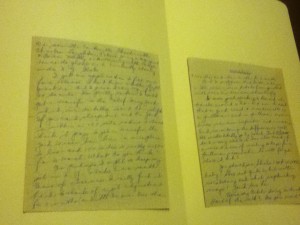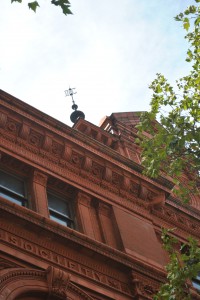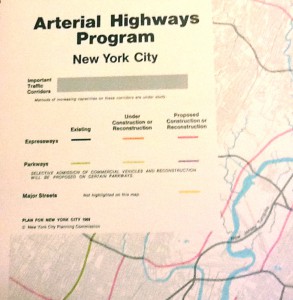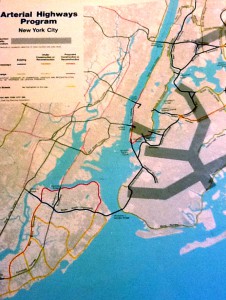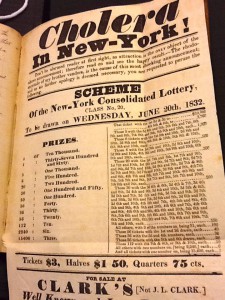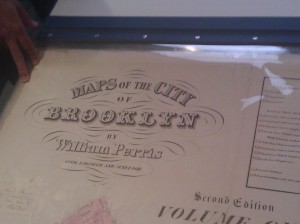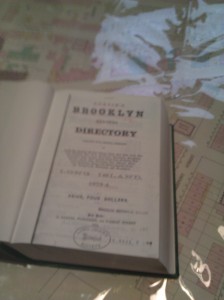K. Valencia
Prof. Gold
Eng. 1101
December 17, 2011
Brooklyn Historical Society:
Urban History Center
Throughout my semester I’ve had the privilege of attending class at the Brooklyn Historical Society. The Brooklyn Historical Society is a museum and library that help us gain more insight into Brooklyn and its history. It grants us access to all sorts of documents, first and second hand. These documents range from letters and newspaper clippings to maps and atlases and even digital versions of all these resources. Going to the Brooklyn Historical Society can help anyone in their investigation and promote more research within any topic. It helped me and my classmates with our research on Brooklyn and the shaping of urban spaces and it can certainly help any individual with a knack for research.

 Visiting the Brooklyn Historical Society is enchanting to say the least. The building’s exterior is all red brick, differentiating it from the rest of the buildings surrounding it. Even at a distance it is very noticeable. Looking closer you can see several head sculptures along the sides. Clearly, they were there not just for aesthetic purposes, but also to give the building a more historic vibe. It is also a very comfortable place to be in. When I stepped foot inside I felt at home. The librarians were very friendly and the interior of the building was as welcoming as the exterior. The colors and materials used were meant to make visitors like me feel just that, welcomed. This library felt especially great to be in. Like one of my classmates said, the library made me want to read and investigate.
Visiting the Brooklyn Historical Society is enchanting to say the least. The building’s exterior is all red brick, differentiating it from the rest of the buildings surrounding it. Even at a distance it is very noticeable. Looking closer you can see several head sculptures along the sides. Clearly, they were there not just for aesthetic purposes, but also to give the building a more historic vibe. It is also a very comfortable place to be in. When I stepped foot inside I felt at home. The librarians were very friendly and the interior of the building was as welcoming as the exterior. The colors and materials used were meant to make visitors like me feel just that, welcomed. This library felt especially great to be in. Like one of my classmates said, the library made me want to read and investigate.
The first document I had access to in the library was a first hand letter written by Lucille Kolkin whom we’ve been reading about (“Brooklyn Was Mine” by Jennifer Egan). She was an average woman living in Brooklyn during the 1940’s. It’s amazing how one insignificant piece of paper can be so intimidating. My first thought upon seeing the letter was, how is it the general public can have access to this? I quickly realized I was lucky enough to see it. Reading Lucy’s script was tedious but we got through it. Lucy’s letter wasn’t all that different from what any other person would write. Her letter was relatable. At least to me it was. I think it’s safe to say my classmates felt the same.
After more visits to the Brooklyn Historical Society, I started gaining some knowledge and experience in research and investigation. My class started to look up the Brooklyn Theater Fire that took place on December 5, 1876, an accident that ruined and destroyed many lives. The fire brought the death of over 278 individuals. Not only did I learn about the victims and the many deaths that took place, but also how this affected the victim’s families, like a chain reaction. My group looked over documents with information about the victims such as general income, age, and dependents they had. Generally, all the victims had a family they were providing income for. Left behind were, elderly parents, and young children with no means of supporting themselves.
Seeing these documents firsthand, some of them handwritten, is very heart wrenching and a lot more personal. I started piecing all the information I had so far. The Brooklyn fire helped us learn more about the shaping of urban spaces. As an architecture student, I slowly started to relate all my classes together.
Ultimately every visit to the BHS is as enlightening as the last. The librarians were welcoming and informative in every visit. Another major resource the Library has is the database. The database is filled with about eight thousand pictures and digital versions of archived documents. Searching through these files can be a very difficult task if you don’t know how to search right. Any one who might want to search in the libraries database wouldn’t run into the most user-friendly interface. You have to know what you’re searching for or if you’re browsing, what you eventually want to come across with. Although the database may be a little clunky to use, it proved to be a useful and convenient tool for research.

Image From www.brooklynhistory.org - Stereograph depicting Johnson St. after the Brooklyn Theater Fire, December 5, 1876. Waller & Schrader, Photographers. V1972.1.923
In addition to using the library database for research, another great resource available are the atlases. We dedicated one entire class to atlases and their uses. Like the database, we came across a few hiccups while looking for the maps of Brooklyn. That’s not to say that these maps were useless and inconvenient. Even the hiccups we came across helped us understand our topic a little more. Ultimately, when doing research, you have to know what to look for and how you want to look for it.
After several visits you can start piecing together everything you’ve come across with at the Brooklyn Historical Society. Every bit of information complement each other. Sometimes one resource leads you to the next. For example, when I was looking through Lucy’s letters, she mentioned the Brooklyn Navy Yard several times. I decided to look up the navy yard in the maps and atlases. Not only did I find the Brooklyn Navy Yard, I also found different maps showing all sorts of information about Brooklyn. I found maps that showed the population density in Brooklyn, maps that showed where the hospitals and markets were, and even maps with the transit system as it was back in the day.
Research doesn’t need to stop at the library. Through www.brooklynhistory.org you can have access to some of the documents in the database. Archives, manuscripts, oral histories, photographs, and more are at your disposal from your very own computer. This makes everything more convenient. This can help you prepare yourself before your visit to the Brooklyn Historical Society.
I really enjoyed my last visit to the Brooklyn Historical Society. It was the last visit as a class but I’ll be sure to go back again and visit Gabriel Furman’s papers, another very interesting brooklynite I came across with. His journal had everything ranging from the natural disasters, diseases, remedies, and even alcoholic drinks. He wrote about anything and everything that seemed relevant to him. The journal is very similar to modern day blog posts. He has them dated and the BHS librarians conveniently had an index of sorts prepared to guide us through the pages. Maybe it’s the peculiar remedies he has, or maybe its the massive amount of information in his journal that have me wanting to go back. Whatever it is, I’ll find it on my way back to the Brooklyn Historical Society.
I would recommend going to the Brooklyn Historical Society to anyone who is even mildly interested in doing some research or gaining knowledge about Brooklyn and the history around it. Some writers might say that writing proper essay structures and having seamless transitions in your writing is important for any paper. I would agree and add that the actual research and how you research plays a very important role in composing an essay. Go to the Brooklyn Historical Society and give yourself more knowledge about Brooklyn and the stories that follow it.
Works Cited:
Egan, Jennifer. “Brooklyn Was Mine”. RIVERHEAD BOOKS Published by the Penguit Group Penguin Croup (USA) Inc. .17! Hudson Street, NewYork, NewYork lOOl4, USA
Valencia, Kevin “BHS, What’s Red, Old, And New All Over?” Published 09/09/11, https://openlab.citytech.cuny.edu/firedisease/2011/09/09/bhs/
Valencia, Kevin “Brooklyn Historical Society: The 2nd Visit to the Archives” Published 10/09/11, https://openlab.citytech.cuny.edu/firedisease/2011/10/09/477/
Valencia, Kevin “BHS Says, I Say” Published 10/17/11, https://openlab.citytech.cuny.edu/firedisease/2011/10/09/477/
Notes and Memoranda, volume 6, circa 1831- 1832; Gabriel Furman papers, ARC 190, Box 2, Folder 2, Brooklyn Historical Society.

